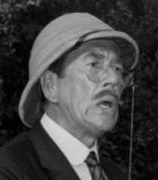|
Comrade Koba posted:Alright, so I dug up granddad's book and read through the relevant chapters. The thing to keep in mind is that this isn't a day-by-day war diary like some of the others posted in this thread, but rather a bunch of recollections of stuff that happened during the war years. There will probably be omissions of stuff that would be of interest to milhist nerds, as well as detailed accounts of stuff that's not really that interesting. I'll simply write the text up the way it's presented. Photos are important to keep, make sure they don't rot in a basement.
|
|
|
|

|
| # ? Apr 27, 2024 04:27 |
|
Ensign Expendable posted:Photos are important to keep, make sure they don't rot in a basement. I've been telling my relatives for 10+ years that they need to get all that poo poo organized and digitized, but it seems it'll never happen unless I do it myself. 
|
|
|
|
https://i.imgur.com/H4N8f2V.gifv Did medieval India not have the trebuchet?
|
|
|
|
BalloonFish posted:Yes. And it wasn't just some doctrinal guff about retaining the offensive spirit and elan. When the Western Front stalemated in 1914 the Germans deliberately settled their position on the high ground, being willing to drop back a few miles (or make a concerted advance if needed) to end up with the height advantage. As well as the age-old tactical advantages of line of sight, artillery range and having your enemy attack uphill, it had geological advantages. Flanders and northwestern France is ridges or isolated hills of chalk above low-lying fields of clay and loam. So the Germans were not only willing to put the effort into building superior trench systems but they were dryer and more pleasant (less unpleasant, really) to be in and the chalk hills meant you could engineer deep, large and dry bunkers and tunnels which would just flood and collapse if you tried the same thing on the plains. Everyone's favorite poilu Louis Barthas did say that the French also had deep, well ventilated, dry bunkers. Reserved for the officers, of course, not the common swine.
|
|
|
|
zoux posted:https://i.imgur.com/H4N8f2V.gifv Is it wrong that I saw that and my only real complaint is you don't cut the rope on a catapult?
|
|
|
|
Your first thought should really be GIVE ME THE NAME OF THAT FILM.
|
|
|
|
|
SeanBeansShako posted:Your first thought should really be GIVE ME THE NAME OF THAT FILM. Don't leave us hanging...
|
|
|
|
Baahubali 2. It's on Netflix. https://streamable.com/gheqj Are there primary sources attesting to the success of the Flying Six Man Testudo? zoux fucked around with this message at 17:57 on Dec 15, 2017 |
|
|
|
SlothfulCobra posted:Is it wrong that I saw that and my only real complaint is you don't cut the rope on a catapult? They are using a bent tree, such an ad hoc catapult system would need a rope.cutting style release mechanism
|
|
|
|
indian movies loving rule with no question
|
|
|
|
9/10 but he should have combined it with the scene from lord of the rings where legolas surfboards down a flight of stairs on a shield and does a sweet kickflip to launch it into an orc's face at the end. But yes seconding that Indian cinema is the pinnacle of moving pictures as an artform.
|
|
|
|
OwlFancier posted:9/10 but he should have combined it with the scene from lord of the rings where legolas surfboards down a flight of stairs on a shield and does a sweet kickflip to launch it into an orc's face at the end. That is The Miami Connection sir.
|
|
|
|
P-Mack posted:That means giving more of France to the Hun. Or in the case of the BEF, handing over the last sliver of Free Belgium. Politically they were in a much tougher position. Key point to note - by and large the Allies did try to choose sensible positions for their fixed lines, albeit there are some places where to have a line running from A to B you just have to have troops at C, where you can't achieve more than shell-holes. Conditions were at their worst during offensives - when you are in a 12 week effort to move the line forwards there's no falling back from where the last attack consolidated at because you'll just have to come back and do it all over again - you have to grit and bear it.
|
|
|
|
OwlFancier posted:9/10 but he should have combined it with the scene from lord of the rings where legolas surfboards down a flight of stairs on a shield and does a sweet kickflip to launch it into an orc's face at the end. I see you didn't watch the clip
|
|
|
|
Wait that's a clip? Watching now. E: Ok, 10/10. OwlFancier fucked around with this message at 18:37 on Dec 15, 2017 |
|
|
|
If anybody wants to read the USS Hornet's internal newspaper from 1944, clicky
|
|
|
|
Grand Prize Winner posted:Hey, I bet this has been gone over before but can anyone recommend a good high elf army composition for the final vortex battle? I play on Normal difficulty and usually just use multiple stacks of low-level infantry/archers with a couple of bolt-throwers along for the ride but that doesn't seem to be cutting it for the last fight. Bear destroyers riding landsknechts
|
|
|
|
Nebakenezzer posted:If anybody wants to read the USS Hornet's internal newspaper from 1944, clicky quote:Foster, GM1c, home on leave was sitting with his cat before the fire. His wife had to go and visit some relatives and warned him to keep an eye on the fire. This made me laugh harder than I'd like to admit.
|
|
|
|
zoux posted:https://i.imgur.com/H4N8f2V.gifv Seems legit.gifv
|
|
|
|
|
|
|
|
13th KRRC War Diary, 15th Dec 1917 posted:Our heavies shelled Circus Point today for half an hour (30 6" shells). One of the enemy was seen to leave one of the dugouts, and fall, apparently hit. No lights of any kind were sent up during the shelling. 2/Lt. LOW and 2/Lt. CAMPBELL carried out a joint patrol with 22 men. JcDent posted:The goon who's doing the WWI battalion journal posts is in December 1917 and the British trenches are still "reinforced shell holes?" That gives them less than a year to get normal movie trenches going, what the gently caress? How were the British so bad at trenches? They're currently about 4 miles S.E. of Ypres (I wish I'd known this in August when we were visiting the area - went to Sanctuary Wood which is only a mile away). The battle of Third Ypres (a.k.a. Passchendaele) just recently ended and this is right at the South end of the area involved. Looking at the position of the front line it was maybe a quarter of a mile ahead of where it started the battle in August. The location was also part of the advance (at the North end, this time) during the battle of Messines Ridge in June. There was a lot of rain during this Autumn. Others have already pointed out the salient points. Deep "movie" trenches were more prevalent in the drier ground to the South, but anywhere the line was static for any length of time they would of course improve the line they were holding. The Ypres lines started out by chance, pretty much, but the Germans, on the defensive, were able to pick their positions and the Entente politically had to attack. The area around the city was hot all through the war - I described it to our eldest (11) as the entire population of the city of Exeter (closest city to home) being killed, every 3 months, for the whole period of the war - and this just in the vicinity of Ypres. Things did change a relatively large amount a few times. Further South in the Somme area the Germans withdrew to the Hindenburg Line of fortifications in early 1917 to shorten their lines. This was the same ground over which they advanced in Operation Michael in March 1918. TL;DR : they had movie trenches, but every time they tried to move General Melchett's drinks trolley six inches towards Berlin they had to start work on them again from scratch.
|
|
|
|
Ensign Expendable posted:Photos are important to keep, make sure they don't rot in a basement. What's the best way to preserve an old photo? I've inherited an old photo of my grandfather's grandfather (taken sometime in the late 19th century), and it's slowly rotting up in my attic.
|
|
|
|
TheAwfulWaffle posted:What's the best way to preserve an old photo? Then you'll want to get some kind of archival grade, acid-free and pH-neutral folder or sleeve for it - best if you can get a sleeve and then put it in a folder. Alternatively a chemically inert bag or envelope would work as well. If you can keep light off it as much as possible, that will help it last. You can still take it out to show it, but the less handling and exposure the better. I would also see if you can get it digitized and then retouched, that way you have a copy you can put in a frame for display, while keeping the original safe.
|
|
|
|
Matilda III and IV in the USSR Queue: 76 mm gun mod of the Matilda, Renault FT, Somua, SU-122, SU-122M, KV-13 to IS, T-60 factory #37, D.W. and VK 30.01(H), Wespe and other PzII SPGs, Pz38(t) in the USSR, Prospective French tanks, Medium Tank M7, Churchill II-IV, GAZ-71 and GAZ-72, Production and combat of the KV-1S, L-10 and L-30, Strv m/21, Landsverk prototypes 1943-1951, Pz.Sfl.V Sturer Emil, PzII Ausf. G-H, Marder III, Pershing trials in the USSR, Tiger study in the USSR, PIAT, SU-76, Heavy tanks M6, M6A1, and T1E1, SAu 40 and other medium SPGs, IS-2 (Object 234) and other Soviet heavy howitzer tanks, T-70B, SU-152, T-26 improved track projects, Object 238 and other improvements on the KV-1S, Lee and Grant tanks in British service, Matilda, T26E4 Super Pershing, GMC M12, PzII Ausf. J, VK 30.01(P)/Typ 100/Leopard, VK 36.01(H), Luchs, Leopard, and other recon tanks, PzIII Ausf. G trials in the USSR, SU-203, 105 mm howitzer M2A1 Available for request:  IM-1 squeezebore cannon 45 mm M-6 gun Schmeisser's work in the USSR Object 237 (IS-1 prototype) SU-85 T-29-5 NEW  25-pounder Cruiser Tank Mk.I Valentine III and V  37 mm Anti-Tank Gun M3 Gun Motor Carriage M8 36 inch Little David mortar Medium Tank M3 use in the USSR 15 cm sIG 33 10.5 cm leFH 18 7.5 cm LG 40 10.5 cm LG 42 Tiger (P) Stahlhelm in WWI Stahlhelm in WWII Pz.Sfl.IVc PzIII Ausf. E and F Ferdinand NEW Semovente L40 da 47/32  47 mm wz.25 infantry gun 7TP and Vickers Mk.E trials in the USSR
|
|
|
|
Comrade Gorbash posted:First thing is to get it out of the attic.
|
|
|
|
Cyrano4747 posted:Digitization is the big one. A lot of old photos were made with chemical techniques that will fade whatever you do. Get a copy that won’t degrade. And then BACK THAT poo poo UP! Hard drives die.
|
|
|
|
GotLag posted:And then BACK THAT poo poo UP!  preferably in case your house floods or w/e. preferably in case your house floods or w/e.
|
|
|
|
As promised, here's the first part I've written up from granddad's memoirs. It's a bit short, but there's more to come. One thing to remember when reading these updates: Unlike all the other Germans who were "only following orders" and "never really liked the Nazis" or "just did as they were told", my grandfather was an unrepentant Nazi well into his fifties. He changed a whole lot later on (I'll write more about this later), but keep this in mind for the moment. Now and then in the text there's the occasional "NOT ALL GERMANS!"-style rambling tangent, but I won't be including those. If you're curious, just go to 4chan or Reddit, it's basically the same dumb poo poo that gets posted over there. Since I'm not including the parts about his childhood and adolescence, here's the tl;dr version: My grandfather was born in Berlin in 1921, the eldest of two sons. His father worked at the stock exchange, so the family was fairly well-off but not wealthy in any way. As a child he was in the Hitlerjugend, which I distinctly remember him describing at one point as being basically non-stop Boy Scout Fun Times. In 1938 he applied to be an officer cadet in the Kriegsmarine, but was turned down because the amount of applicants was too high. He then wanted to apply to the Luftwaffe as a pilot , but was convinced by his parents to apply as a communications officer instead (they'd witnessed an airplane crash up close on one occasion and wanted him to remain on the ground). He did eventually become a pilot anyway, but more on that later. Early in 1939 he was drafted into the Reichsarbeitsdienst (National Labour Service), where he did construction work for a few months. In july that same year, the unit recieved some basic firearms training and were transported to the Polish border. The official explanation at first was that they were to defend the border in case of attack by "militant Polish partisans".  Well, we all know what then happened on September 1, 1939. quote:1. Poland
|
|
|
|
Comrade Koba posted:Reichsluftfartsministerium Heh.
|
|
|
|
This may be a bit late, but I have an ad on to make to the grandfather chat. I forget who it was who actually posted that their grandfather ended up as a prisoner of war and sent to the US as labor, but like with almost everything at the time in the US, it turns out that this was another fun part in the hilariously hosed up story of racism in the US. Going from NAACP records, it actually become a complaint of the black population in the south that this forced labor was used as a way to make them redundant. While this is not really surprising, however this was a note attached to a letter of complaint sent from one of the army bases in Florida. So one of the uses of these prisoners of war was to be used as catering staff at this particular camp and at the time while the camp wasn't completely full, a relatively decent cafeteria had been assigned German prisoners to run it in serving food to black soldiers. In a sane world this would be a hilarious story of comeuppance for racist assholes, but what ended up happening was that the black soldiers were forced to use a different dining hall because the prisoners had complained to the head of the camp that it was degrading to have to serve a lesser race like this. From a general research perspective I was quite glad to have found this. During my initial research, as this was for a paper I was doing for class, I had found an article that made reference to the hosed up social dynamic in the south when it came to prisoners of war getting treated better then African American men who had signed up/been drafted to fight and die for the US. I was slightly iffy about including it in my paper as the article had said that it wasn't exactly clear if this was just a rumor that seemed so likely that many black vets brought into the idea that it actually happened, so actually finding evidence about this issue was quite useful. Some other highlights of what I found was a quote from another black soldier saying "Lord, this army is providing me with an experience which I shall never forget. … Never shall I condemn tyranny abroad without condemning that at home. The United States cannot honestly boast of its freedom. In New York I questioned its truth. In the south I condemn it as hypocrisy. “We are not free. We are only tolerated." And an English serviceman being confused and slightly offended when he was instructed to be "friendly but not too friendly." to black serviceman as this had proven to be too much for southern soldiers to take as their attempts to 'educate' the locals that black soldiers were barely better then animals who were routinely chained up back at their camp failed to stick. Of course this isn't to say that England wasn't racist it was just not as bad as the US.
|
|
|
|
13th KRRC War Diary, 16th Dec 1917 posted:2/Lt. MARSHALL and 2 O.R.reconnoitred the ground from TOP HOUSE to FUNNY FARM.
|
|
|
|
I’ve been reading along this thread for years now but haven’t posted much, but grandpa chat made me remember that I have something worth posting. Alot of it isn’t strictly military history, but it’s way too good to not post. I wanted to get this in last week but it took me awhile to get the digital versions from my mom. I was going to ask if anyone is interested but fuckit  My maternal grandfather was in the US Navy during WWII, serving on the USS Tinsman, a Rudderow class destroyer escort. I knew about this growing up but didn’t have many of the details except little anecdotes that I heard over the years, until grandpa was cleaning out his house a few years ago and came across a bunch of papers he’d kept since then. My mom being a huge nerd immediately decided that all of this needed to be digitized and recorded, which is how I have all of this now.  Here’s the man himself, Seaman 2/c at the ripe age of 18. This picture is a bit weird for me since he looks amazingly like me and one of my cousins. Since he was so young during the war, and by some stroke of luck, he’s still alive and amazingly spry. His hearing’s shot to hell but he’s all there mentally. I helped him build a shed last summer where he was pounding in 3in nails by hand all afternoon, then we went out for beers. It was awesome. If anyone has any questions that I can pass along I’d be happy to ask them, I’ll be staying over at his place for Christmas next week. The rest of this was created by my mom from the documents grandpa found, so I’ll just copy-paste from the book from here. All of this is taken directly from the typed up and collated book she put together and had printed as christmas gifts a few years back: xDx’s mom posted:This book is a compilation of the personal war mementos of xDx’s grandpa. It started as a project to transcribe the ‘Combat Dope Sheets’ into a more readable format, since the originals are somewhat faded. The term ‘dope’ is slang for ‘information,’ and the Dope Sheets chronicle the travels of the U.S.S. Tinsman. I have attempted to recreate them in a format as close to the original as possible, including typos, grammatical errors, and the original artwork. Dad remembers that these were put together primarily by Robert Bland, who was an officer on the Tinsman, but I suspect others contributed due to differences in writing style and some repetition here and there. The author refers to himself as COMBAT at times in the narrative. The dope sheets are pretty remarkable, especially considering they were created on a manual typewriter. They are part travel guide, geology report, history lesson, and story-telling, sometimes all within the same paragraph. They are very entertaining, and it has been a rare treat to have a glimpse of the crew’s wartime experience from their viewpoint.  Sweet sweet dazzle camo.    The Captain  The Bastards  “C” Div.  2nd Deck Div  1st Deck Div  “O” Div  “E” Div  Cooks and Bums     COMBAT DOPE SHEET #1 Panama City  COMBAT posted:The Canal was started by the French in 1882 and by 1904, they were so discouraged that they sold their shovels to the U. S. for a song – yellow fever and landslides in “Culebra Cut” had ‘em licked. U. S. rented a slab of land 10 miles wide from the Republic of Panama (at 10 million fish per annum and our lease expires midnight Dec 31, 2103. The first job was to eliminate the mosquito in the zone – which was done, as you recall, by Dr. GOETHALS. All stagnant water and breeding places were destroyed. GATUN LAKE was artificially made by damming a river – then when they had a good pressure built up a few sticks of dynamite well placed in the continental divide started the landslide that was later shaped into “CULEBRA CUT”. Many landslides set the work back years – as a matter of fact you‘d better hold your breath when we go thru it because they‘re still working on the job of holding those mountains back. The locks are double- barrelled – each lock being 1000 feet by 110 feet – and can be worked either together or in reverse (They may even put another ship in the lock with us) The canal is 50 miles long, 45 feet deep. Anywhere from 50 -70 ships can go thru the canal each day, and the trip takes 7 1⁄2 hours. The record trip was made by a PT that jumped right over the locks – 4 hours and 10 minutes for the whole trip! On the Pacific side PANAMA CITY rests high above the sea. A Spanish-American city started in 1518— lots of overhanging balconies, Chinese shops, East India stores, and stuff— Pop. 75,000. The Atlas says it has fine churches, banks, and a college.  COMBAT DOPE SHEET #2 Galapagos Islands  COMBAT posted:If you wanted to pick one of the best spots in the world to plant a victory garden, the GALAPAGOS ISLANDS (pronounced gaa-laa-gose) would be it. This group of 15 main islands was born out of the eruptions and overflow of thousands of roaring volcanoes, and the black lava, once it cooled down, make an excellent soil. Of course you‘d better peer over the rim of the volcano before you settle down on your island because some of the volcanoes are not yet extinct. Some were last seen belching smoke, fire, and lava in 1942. If you manage to find a nice house-broken volcano, you can settle down to some fancy radish-raising in the valley, provided you have a couple of oxen to haul water for you during the dry season. If after all these precautions you still cannot raise a full-grown radish, there is another recourse for you- you can use the same oxen but instead of barrels you‘ll need a shovel and cart. For, swarming around these islands are many, many pure white seagulls, untained by civilization – sea-gulls that are so clean and fine that their manure is a thing of beauty and refinement, and may be used for the fertilization of the daintiest of daisies. This unique stuff is called "guano"; and is simply shoveled off the rocks, where these well-trained birds deposit in an orderly fashion. At one time a less clean species of sea-gull began to hang around the islands, but the thoroughbreds were forced to chase them away because of the inferior quality of their ex(c)retion. They were simply lousin‘ up the stuff.  COMBAT DOPE SHEET #3 South Sea Islands COMBAT posted:FORGET THE SMOKE AND NOISE OF THE CITY, AND THE BUSY TOIL OF FARM AND FACTORY, AND FLY ON THE MAGIC CARPET OF THE "TINSMAN"; ALONG THE GODEN TRAIL OF THE SETTING SUN, WHICH LEADS OVER THE BLUE VASTNESS OF THE PACIFIC TO THE ENCHANTED ISLANDS OF ROMANCE. (P.S. and don‘t forget this would cost you 3000 bucks in peacetime)    This keeps going through COMBAT DOPE SHEET #19. Most of them are more like the first 3, but as the mighty TINSMAN gets further into the war there's more war news included. edit: fixed img problems oXDemosthenesXo fucked around with this message at 21:50 on Dec 16, 2017 |
|
|
|
First image is broken.
|
|
|
|
Those are cool as gently caress please immediately post all of them
|
|
|
|
KYOON GRIFFEY JR posted:Those are cool as gently caress please immediately post all of them It'll take me some time to get it all together, it took at least an hour to do that post. I'll try to hammer out a set every day or so.
|
|
|
|
A friend of mine is home for Christmas and found this shaving mug - likely belonged to her grandparents: 
|
|
|
|
That sheet is pretty dope. 76 mm gun for the Matilda Queue: Renault FT, Somua, SU-122, SU-122M, KV-13 to IS, T-60 factory #37, D.W. and VK 30.01(H), Wespe and other PzII SPGs, Pz38(t) in the USSR, Prospective French tanks, Medium Tank M7, Churchill II-IV, GAZ-71 and GAZ-72, Production and combat of the KV-1S, L-10 and L-30, Strv m/21, Landsverk prototypes 1943-1951, Pz.Sfl.V Sturer Emil, PzII Ausf. G-H, Marder III, Pershing trials in the USSR, Tiger study in the USSR, PIAT, SU-76, Heavy tanks M6, M6A1, and T1E1, SAu 40 and other medium SPGs, IS-2 (Object 234) and other Soviet heavy howitzer tanks, T-70B, SU-152, T-26 improved track projects, Object 238 and other improvements on the KV-1S, Lee and Grant tanks in British service, Matilda, T26E4 Super Pershing, GMC M12, PzII Ausf. J, VK 30.01(P)/Typ 100/Leopard, VK 36.01(H), Luchs, Leopard, and other recon tanks, PzIII Ausf. G trials in the USSR, SU-203, 105 mm howitzer M2A1 Available for request:  IM-1 squeezebore cannon 45 mm M-6 gun Schmeisser's work in the USSR Object 237 (IS-1 prototype) SU-85 T-29-5 NEW  25-pounder Cruiser Tank Mk.I Valentine III and V  37 mm Anti-Tank Gun M3 Gun Motor Carriage M8 36 inch Little David mortar Medium Tank M3 use in the USSR 15 cm sIG 33 10.5 cm leFH 18 7.5 cm LG 40 10.5 cm LG 42 Tiger (P) Stahlhelm in WWI Stahlhelm in WWII Pz.Sfl.IVc PzIII Ausf. E and F Ferdinand NEW Semovente L40 da 47/32  47 mm wz.25 infantry gun 7TP and Vickers Mk.E trials in the USSR
|
|
|
|
Nebakenezzer posted:A friend of mine is home for Christmas and found this shaving mug - likely belonged to her grandparents: I’ve got a similar porcelain doll thinger from my grandparents with the same stamp.
|
|
|
|
I feel like this piece of satire was crafted specifically for this thread: http://thehardtimes.net/harddrive/history-channel-documentary-just-world-tanks-livestream/
|
|
|
|

|
| # ? Apr 27, 2024 04:27 |
|
Comrade Koba posted:I remember September 1, 1939 very well. We had been issued yellow armbands with the words “Deutsche Wehrmacht” printed in black, as well as bayonets but no firearms. ... HEY GUNS fucked around with this message at 16:21 on Dec 17, 2017 |
|
|

































